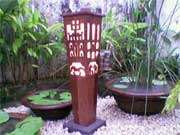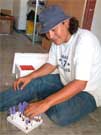By ELIZABETH PISANI
598 words
19 March 1996
<
Asia Times
English
(c) 1996 Chamber World Network International Ltd
All that is gold does not glister - as Cambodia's farmers are about to find out.
Golden apple snails, more elegant in their shells than the sludge-colored local variety, are being flogged to farmers as an extra money-maker. They are new, goes the sales pitch, they are exotic, they will shoot to the top of the restaurant menu hit parade and bring in lots of cash.
But, far from being gobbled up by enthusiastic diners, golden apple snails enthusiastically gobble rice crops. Already a major pest in Vietnam and the Philippines, the snails have only just made their appearance in Cambodia, and the pattern of their spread - outward along the major trade routes from Phnom Penh - suggests they have been introduced deliberately.
"It is like a bizarre pyramid selling scheme," said Gary Jahn, a Cambodian-IRRI-Australia Project agronomist.
A few months ago, snails were sold for breeding at US$6 a kg, but eager restauranteurs failed to materialize. Golden apple snails may be pretty, but they are bitter and not as good to eat as the Cambodian varieties, which show no interest in rice.
Now the price has imploded to less than a tenth of peak levels, but breeders still sell them to their friends and neighbors in the hope of recouping their initial investment.
Normally, once people realize a pyramid selling scheme is a fraud, it collapses. "The difference with this one is that it breeds all by itself," Jahn said. "After you realize it doesn't work, what do you do? You throw them in a lake, throw them in a river, and they go on breeding."
Golden apple snails in the Tonle Sap, the giant lake that feeds Cambodia's waterways and rice fields, are an agronomist's worst nightmare. A geographical oddity, the river that feeds the Tonle Sap flows in different directions at different times of the year, making control next to impossible.
No one seems willing to listen to the experts' cries of alarm. For one thing, people find it hard to distinguish the snails from the old, benign ones - especially when they are covered with the mud.
The major difference is in eggs. While Cambodian snails lay theirs in the mud, the bright pink golden apple snail eggs are stuck in clumps on rice stems, looking like something in a Tokyo sushi bar.
Even farmers who know they have the new snails refuse to believe they are dangerous. The major snail selling boom came late in the last crop season - too late for any damage to be done. But snails will burrow into the mud as it dries, emerging after the next rains to attack the crop.
In a country such as Cambodia, where rice farming is of relatively low intensity, it may take several seasons for the brunt of snail damage to be felt. But by that time, the mollusks may be unstoppable.
Taiwanese farmers are rich and well-educated enough to use poisons against snails, but agronomists are reluctant to promote such a solution among the poorly-educated Cambodian farmers, already overloaded with toxins.
Indonesia banned snail breeding some years ago and experts have urged Cambodian authorities to do the same, but other priorities clamor for the attention.
"The only advantage that I can think of is that golden apple snails are good to feed to your ducks. But then so are ordinary local snails, and they don't eat up your own dinner," Jahn said.
Copyright 1996 Asia Times.
(c) 1996 Chamber World Network International Ltd.




